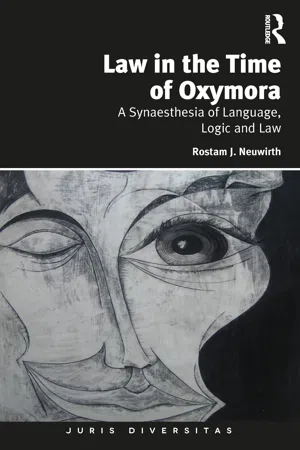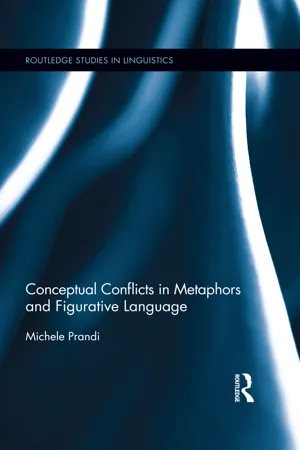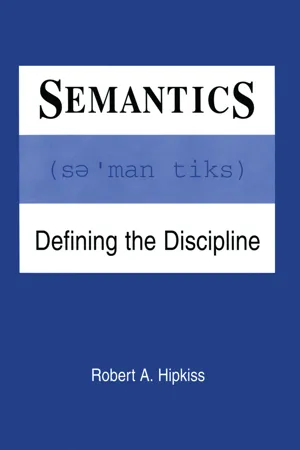Languages & Linguistics
Oxymoron
An oxymoron is a figure of speech that combines contradictory terms to create a paradoxical effect. It often involves the juxtaposition of words with opposite meanings to convey a complex or ironic idea. Examples of oxymorons include phrases like "bittersweet," "jumbo shrimp," and "deafening silence." This literary device is commonly used in poetry, literature, and everyday language to evoke thought-provoking or humorous effects.
Written by Perlego with AI-assistance
Related key terms
3 Key excerpts on "Oxymoron"
- eBook - ePub
Law in the Time of Oxymora
A Synaesthesia of Language, Logic and Law
- Rostam J. Neuwirth(Author)
- 2018(Publication Date)
- Routledge(Publisher)
p.25 4 Essentially Oxymoronic concepts in art and scienceThe mystical experience has in its history with language applied specific modi loquendi, namely primarily paradox, Oxymoron, negation etc., which are all rhetorical figures expressing a kind of swoon, which ought to express the superior power of the experience, the ineffability of the experienced.1Art and science both qualify as contested concepts and both have and continue to lead to endless disputes. One such dispute may also include the question of their mutual relation, whether they are really one field or two different fields of human efforts. It is also possible that they may share many goals but differ in other aspects or are similar and dissimilar at the same time. It is noteworthy that one important aspect in which they are said to differ is in their acceptance and use of essentially Oxymoronic concepts:Yet there is a sense in which paradox is the language appropriate and inevitable to poetry. It is the scientist whose truth requires a language purged of every trace of paradox; apparently the truth which the poet utters can be approached only in terms of paradox.2Whether this difference in the use of Oxymoronic language is in line with the present paradigm or Zeitgeist and generally still holds true today needs to be assessed. There are overlaps and, especially, overlaps in terms of the cognitive and mental processes underlying artistic creations and scientific discoveries, which are worth noting. Linguistically, these overlaps surface in the contradictions in terms reflected by the enantiosis of genius and madness (Genie und Wahn ) that has been applied to persons engaged not only in art3 and science,4 but also philosophy5 and politics6 .7 - Michele Prandi(Author)
- 2017(Publication Date)
- Routledge(Publisher)
7 The mix of antiphrasis and polyphony documented by such uses of Oxymoron is reminiscent of irony (Ch. 8, § 3).8 See Panther and Thornburg (2012, 183): oxymora “are appropriate linguistic devices to express conflicting feelings and emotions”.9 Petrarca, The Canzoniere .10 On the Universe : fr. XXXVI11 Homer, The Odyssey : 19.12 On the Universe : fr. XXXIX.13 Greek Lyric , I.14 The Canzoniere .15 Selected Poems of Friedrich Hölderlin .16 Some scholars see the different forms of contradictory utterance as different kinds of figures. Cellier (1965), for instance, uses the term antithesis to refer to the coordinative form—the type Odi et amo —and restricts the term Oxymoron to the subordinative form; see also Molinié (1992, 235). This is reminiscent of the taxonomic attitude of ancient rhetoric, which hides the essential conceptual and grammatical properties of figures behind a proliferation of labels.17 This also holds for apparent oppositions to be found among classificatory concepts, which are not formal-lexical but real, so to speak—for instance, ‘man’ versus ‘woman’ and ‘boy’ versus ‘girl’ (Panther and Thornburg, 2012). Such a statement as This man is a woman , for instance, would be interpreted as a metaphor projecting onto the man the model of the woman.18 Double classification is the logical form of such monsters as centaurs or chimeras and the key for understanding such exocentric portmanteau words as smog, brunch , or carrottle , as Cardinal (1974) terms Magritte’s painting L’Explication (1954), which blends a bottle and a carrot to form a sort of missile. When analytical concepts are put into conflict—This square is a triangle; This is a square and a triangle- eBook - ePub
Semantics
Defining the Discipline
- Robert A. Hipkiss(Author)
- 2014(Publication Date)
- Routledge(Publisher)
Chapter 7CONTRASTIVE FIGURES OF SPEECHMetaphor, synecdoche, and personification are all comparative figures of speech. There are figures and modes that are contrastive: paradox, Oxymoron, irony, and puns. These too deserve some discussion as to the method of their meaning.Paradox and Oxymoron
As shown in the earlier chapter on logic, linguistic paradox is really a matter of using words that invite a conventional response only to show that the conventional response is inappropriate or incomplete. For instance, as we have seen before, a yes-no response cannot properly be given to the question of whether a man has stopped beating his wife if he has not beaten her. Here is another paradoxical statement, borrowed from a handbook of rhetoric (Treble & Vallins, 1936): "He who goes against the fashion is himself its . . ." (p. 135). What word would you use to complete this quote from Logan Smith? "Refashioner"? No, Smith does not see nonconformity as having that sort of power. His word is "slave."Now, how is it that one who goes against something becomes a slave to it? Our conventional response would be that nonconformity is a rebellion against slavishness. We have to think further. Nonconformity to do what? To act in what way? According to what principle? Answer: To do and act in a way that expresses a rejection of the fashion. So a person determined to be unfashionable in never appearing as one who conforms is conforming to a negative code of conduct dictated by what is fashionable, a slave to fashion in spite of himself. The quote makes the point that we are controlled not only by our attractions but by our repulsions as well. What appears to be contradictory diction is found to make perfect sense after all.Oxymorons too are only apparently contradictory. Milton in Paradise Lost
Index pages curate the most relevant extracts from our library of academic textbooks. They’ve been created using an in-house natural language model (NLM), each adding context and meaning to key research topics.


